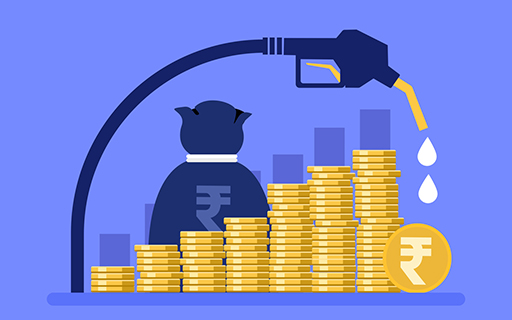- Home
- Archives
INDRAPRASTHA GAS News & Analysis
Here you will find all the research and views on INDRAPRASTHA GAS that we post on Equitymaster. Use the tools to customize the results to suit your preference!
INDRAPRASTHA GAS 2022-23 Annual Report Analysis
Mar 31, 2023 | Updated on Apr 26, 2024Here's an analysis of the annual report of INDRAPRASTHA GAS for 2022-23. It includes a full income statement, balance sheet and cash flow analysis of INDRAPRASTHA GAS. Also includes updates on the valuation of INDRAPRASTHA GAS.
INDRAPRASTHA GAS Fact Sheet, INDRAPRASTHA GAS Financial Results - Equitymaster
Apr 26, 2024 | Updated on Apr 26, 2024Check out INDRAPRASTHA GAS fact sheet and INDRAPRASTHA GAS financial results online at Equitymaster.
INDRAPRASTHA GAS Quarterly Results - Equitymaster
Apr 25, 2024 | Updated on Apr 25, 2024Check out latest INDRAPRASTHA GAS Quarterly Results online at Equitymaster.
INDIA GELAT. Share price, NSE/BSE Forecast News and Quotes| Equitymaster
Apr 25, 2024 | Updated on Apr 25, 2024INDIA GELAT.: Get the latest INDIA GELAT. Share price and stock price updates, live NSE/BSE share price, share market reports, financial report, balance sheet, price charts, financial forecast news and quotes only at Equitymaster.com.
INDRAPRASTHA GAS Share price, NSE/BSE Forecast News and Quotes| Equitymaster
Apr 25, 2024 | Updated on Apr 25, 2024INDRAPRASTHA GAS: Get the latest INDRAPRASTHA GAS Share price and stock price updates, live NSE/BSE share price, share market reports, financial report, balance sheet, price charts, financial forecast news and quotes only at Equitymaster.com.
POWER & INSTRUMENTATION Share price, NSE/BSE Forecast News and Quotes| Equitymaster
Apr 25, 2024 | Updated on Apr 25, 2024POWER & INSTRUMENTATION: Get the latest POWER & INSTRUMENTATION Share price and stock price updates, live NSE/BSE share price, share market reports, financial report, balance sheet, price charts, financial forecast news and quotes only at Equitymaster.com.
TIGER LOGISTICS Share price, NSE/BSE Forecast News and Quotes| Equitymaster
Apr 25, 2024 | Updated on Apr 25, 2024TIGER LOGISTICS: Get the latest TIGER LOGISTICS Share price and stock price updates, live NSE/BSE share price, share market reports, financial report, balance sheet, price charts, financial forecast news and quotes only at Equitymaster.com.
UTI GOLD ETF Share price, NSE/BSE Forecast News and Quotes| Equitymaster
Apr 25, 2024 | Updated on Apr 25, 2024UTI GOLD ETF: Get the latest UTI GOLD ETF Share price and stock price updates, live NSE/BSE share price, share market reports, financial report, balance sheet, price charts, financial forecast news and quotes only at Equitymaster.com.
ZUARI GLOBAL Share price, NSE/BSE Forecast News and Quotes| Equitymaster
Apr 25, 2024 | Updated on Apr 25, 2024ZUARI GLOBAL: Get the latest ZUARI GLOBAL Share price and stock price updates, live NSE/BSE share price, share market reports, financial report, balance sheet, price charts, financial forecast news and quotes only at Equitymaster.com.
 Top 5 Energy Stocks to Watch Out for Big Dividends in 2024
Top 5 Energy Stocks to Watch Out for Big Dividends in 2024
Apr 7, 2024
Energy companies in India are poised for a record-breaking dividend payout driven by significant surge in net profit.
INDIA GRID 7.60% SR2 Share price, NSE/BSE Forecast News and Quotes| Equitymaster
Feb 20, 2024 | Updated on Feb 20, 2024INDIA GRID 7.60% SR2: Get the latest INDIA GRID 7.60% SR2 Share price and stock price updates, live NSE/BSE share price, share market reports, financial report, balance sheet, price charts, financial forecast news and quotes only at Equitymaster.com.
 Top 5 Growth Stocks that Could Bounce Back in 2024
Top 5 Growth Stocks that Could Bounce Back in 2024
Dec 19, 2023
These companies with strong fundamentals and strategic agility are primed to rebound in 2024. Take a look...
 Why Indraprastha Gas Share Price is Falling
Why Indraprastha Gas Share Price is Falling
Oct 4, 2022
Indraprastha Gas share price continues to remain under pressure on account of rising gas prices. Find out other reasons dragging the stock lower.
Indraprastha Gas Ltd: Favorable Policies Boost Prospects
Apr 7, 2016 | Updated on Oct 30, 2019Indraprastha Gas Ltd has reported 1.5% year on year (YoY) decline in the topline for the quarter ended December 2015 while the bottomline for the quarter declined 2.8% YoY.
VAISHNAVI GOLD Share price, NSE/BSE Forecast News and Quotes| Equitymaster
Feb 6, 2017 | Updated on Feb 6, 2017VAISHNAVI GOLD: Get the latest VAISHNAVI GOLD Share price and stock price updates, live NSE/BSE share price, share market reports, financial report, balance sheet, price charts, financial forecast news and quotes only at Equitymaster.com.

